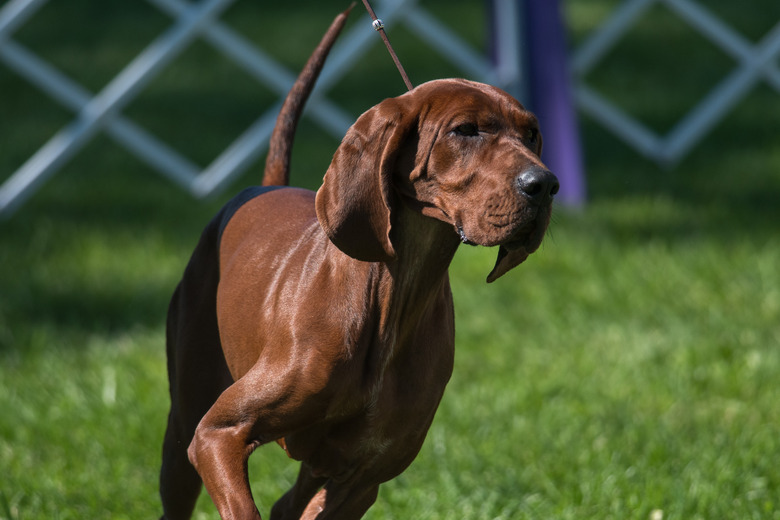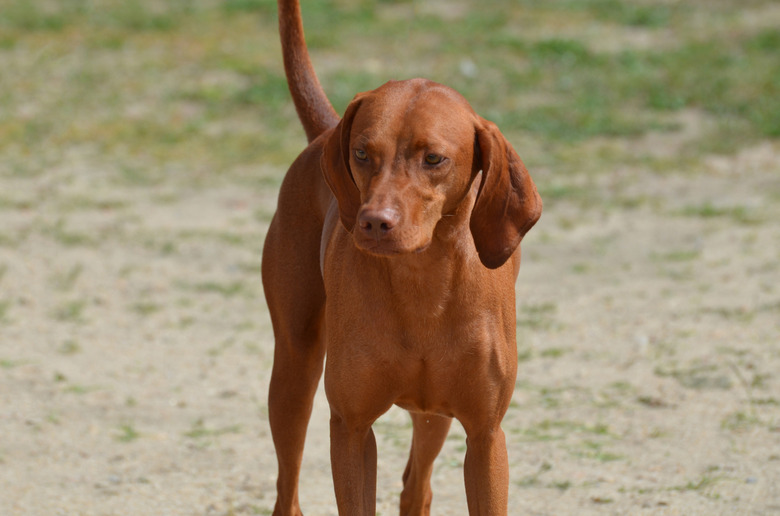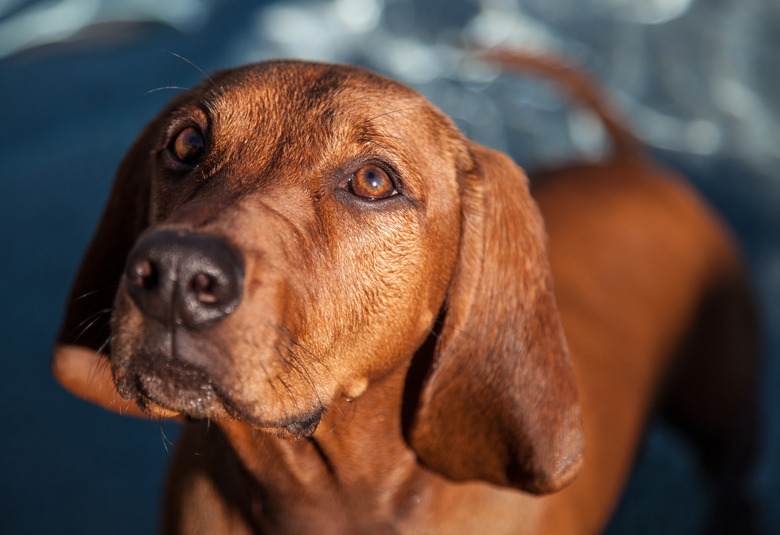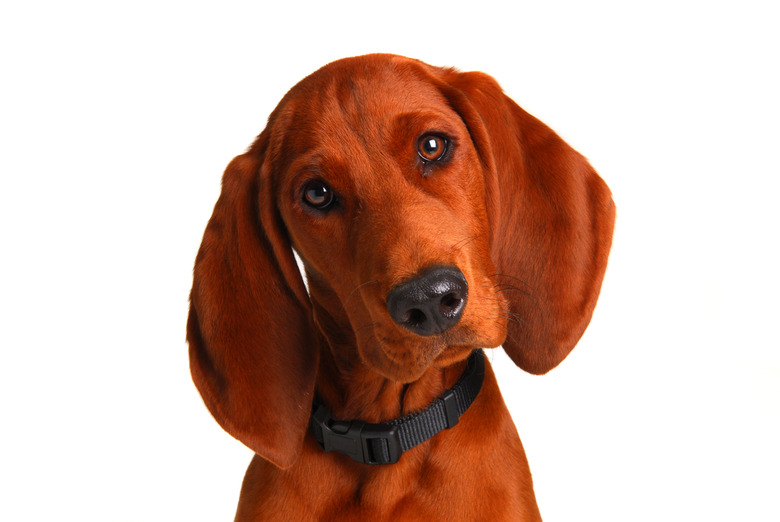Redbone Coonhound Dog Breed Information & Care
Redbone coonhound quick facts
Size: 22 – 27 inches (male), 21 – 26 inches (female)
Weight: 45 – 70 pounds
AKC breed group: Hound group
Lifespan: 12 – 15 years
Coat length: Short
Coloring: Deep red
Grooming needs: Medium
Friendliness: Good-natured, family friendly dogs
Redbone coonhound dog breed history
Redbone coonhound dog breed history
In the mid-1800s, Scottish immigrants to America brought with them their foxhounds, which had deep red coats. They bred them with American hounds and created the Redbone coonhound. This dog is named after the early breder in Tennessee named Peter Redbone and are called coonhounds due to their ability to hunt raccoons. The hallmark of Redbone coonhounds is their beautiful, deep red coat color, which led many people to call any red dog a Redbone. True Redbones, however, get their red coloring from their Scottish roots.
While early Redbone coonhounds had a black saddleback marking, this was bred out, so today's Redbone coonhound will not be found with a saddleback. Some Redbone coonhounds have white on their feet, usually the toes, and possibly on the brisket, which is indicative of their Irish as well as Scottish roots.
Some disagree that Redbone was the first breeder of Scottish and American hounds, giving credit instead to Georgia breeder George F.L. Birdsong or Dr. Thomas Henry. Others say these breeders enhanced the breed that Peter Redbone started by breeding dogs with the desirable traits that the Redbone coonhound possesses today, namely:
- Extraordinary agility on varied terrain
- Webbed feet, giving them the ability to swim and fetch in the water
- Some ability to climb trees, thus trapping prey in the tree
- Courage to hunt prey much larger than themselves, e.g. mountain lions and bears
Is a Redbone coonhound a rare breed?
The Redbone coonhound dog breed is rare outside of the U.S. They were bred in America to be working dogs on farms and capable hunting dogs, not with the purpose of showing them, so their popularity did not expand to Europe, where showing dogs was a main reason for breeding. Redbone coonhounds are plentiful in the U.S., especially in the South as they were originally bred in Georgia. The American Kennel Club officially recognized the breed as a member of the hound group in 2009.
Redbone coonhound dog breed characteristics
Redbone coonhound dog breed characteristics
The most obvious characteristic of the Redbone coonhound dog breed is their gorgeous, deep red, short-haired coat, which the AKC described as looking as though "...a master sculptor carved them from blocks of the finest mahogany" Some dogs may also have white markings on their toes and/or brisket, which is evidence of their Irish hound dog blood as well as Scottish.
Redbone coonhounds are characteristically avid bloodhounds, or more accurately scent hounds, that sniff out a scent of prey and track it relentlessly. They are differentiated from other coonhounds by the traits that were bred into them specifically for American hunting on varied terrain, in water, and cornering prey up trees.
Yet, the Redbone coonhound dog breed is also known for being laid-back when hanging out with the family or relaxing in their midst. They may be too big to be lap dogs, but don't tell that to this affectionate breed with their pleading expression. Just patiently encourage them to lie beside you instead.
Redbone coonhound temperament and training
Redbone coonhound temperament and training
Breed alone is not an accurate predictor of an individual dog's personality. However, Redbone coonhounds are generally regarded as even-tempered, family dogs that are good with children, other pets, and strangers, but determined hunters when on the trail of prey.
Those who see them hunt with such determination and bravery may be surprised to see the same dog calm and serene, curled up with the family later.
Are Redbone coonhounds easy to train?
Redbone coonhounds are highly trainable. As a breed that yearns to be included in the family group, Redbone coonhounds are eager to please. This means that with the right type of training they can be eager learners. For example:
- Always use positive reinforcement, never punishment.
- Be consistent in showing your dog the desired behaviors.
- Make training fun.
- Keep initial training sessions short.
- Give lots of praise with or without treats.
- Practice what has been learned before tackling new skills.
Consider enrolling in a training class where you learn to train your dog. Be sure the training instructor uses only positive reinforcement with rewards of praise and treats, and does not advocate using punishment or fear at all.
Are Redbone coonhounds aggressive?
No, Redbone coonhounds are not aggressive dogs. In fact, a dog's breed is not a reliable indicator of aggression, and it's never fair to assume that any breed is more aggressive than any other.
Redbone coonhounds were bred for hunting, so it should not be surprising when they demonstrate determination while on the trail of prey. They may even be so relentless on their hunt that they ignore your commands temporarily. This is even evident when Redbones are in the yard — what you would call playing is them using their natural hunting instincts to chase other animals.
In addition to breeding, a dog's behavior is a reflection of their upbringing and training. Dogs that act aggressively were not trained to calm down or, in some unfortunate cases, were trained to be aggressive no matter what their breed. For example, an essential part of training Redbone coonhounds for hunting is to teach them to corner their prey, but not to kill them.
Do Redbone coonhounds bark a lot?
Barking "a lot" means something different from one person to another, so it's difficult to say what your assessment would be. All dogs bark, and Redbone coonhounds are considered to be vocal dogs. However, their vocalizing is described as baying rather than barking.
Baying is especially pronounced during hunting when the hound has prey cornered. Redbones will continue to sound their baying alarm to alert hunters of the location of the trapped prey, stopping only when the hunters appear and find them.
Baying is much less pronounced when not hunting, but Redbone coonhounds should not be expected to be quiet dogs. They may be excited when playing too, though their demeanor would not be the same as when hunting prey. And even when they're not involved in traditional hunting, their instinct to chase prey and call out will be evident when they are running after rabbits in the yard, and cornering squirrels or cats up a tree.
Grooming a Redbone coonhound
Grooming a Redbone coonhound
Redbone coonhounds should be groomed weekly with a brush designed for short-haired dogs. Many brushes today are designed with ergonomic features to be comfortable to use, so try holding different styles to see what you like best.
You may be surprised how much hair even a short-haired dog can accumulate! Brushing your Redbone coonhound also distributes oil from the skin through the dog's coat to make it shine.
Follow a schedule like this to keep up on grooming:
- Brush at least once per week.
- Trim nails monthly.
- Regular bathing every 4 to 6 weeks is ideal.
- Brush teeth regularly and have professional dental cleanings.
Redbone coonhound exercise and health
Redbone coonhound exercise and health
The Redbone coonhound dog breed is an overall healthy one, with no inherent health problems to watch for, although they can be affected by hip dysplasia and other maladies that can affect large dogs. As with any dog, a healthy lifestyle and regular veterinary care are necessary to maintain their health. Redbone coonhounds also need daily exercise to stay healthy and happy, which they get naturally if they participate in active hunting.
Long walks, hikes, or runs can give Redbone coonhounds the exercise they need and crave. They will also excel at coonhound training and agility events like field trials, water races, and night hunts. Training your redbone coonhound for these events should be a fun, bonding experience for both you and your dog. Focus on the fun and exercise your dog gets from using the breed's natural instincts to participate in these events, rather than on winning.
When the weather isn't conducive to outdoor exercise, it's important to keep your Redbone coonhound active inside. Play fetch and tug-of-war with soft toys and create a scent trail by hiding treats and toys for them to find. You can even make an obstacle course by arranging pillows, ottomans and other safe, unbreakable household items and teaching them to jump over or run around them.
Raising Redbone coonhound puppies
Raising Redbone coonhound puppies
Newborn puppies feed on their mother's milk as soon as they are born; they should be able to find a nipple on their own and nurse about every two hours. Make sure each puppy is nursing regularly; contact your veterinarian if a puppy is having trouble nursing. Puppies generally begin to transition to solid food when they are around 3 to 4 weeks old. Start by mixing a little puppy milk replacement with dry kibble so it is mushy and easy for them to eat.
As your Redbone coonhound begins to get teeth, gradually add less milk replacement until they can eat the dry kibble. Follow your veterinarian's advice on how often to feed your puppy, which could be four times a day at first, reducing to a typical morning and evening schedule as they leave puppyhood behind.
Like all puppies, Redbone coonhound puppies are rambunctious and need constant attention to keep them safe and keep them from creating whole house havoc. Start training classes as soon as puppies have been fully vaccinated and can safely be in a group setting. While waiting for the go-ahead from your veterinarian, start mini training sessions on your own. Early socialization with other dogs and people will help them get along in a busy environment.
What are the pros and cons of a Redbone coonhound?
What are the pros and cons of a Redbone coonhound?
Redbone coonhounds are known for their gorgeous, deep red coats, but they offer so much more with their affectionate nature and eagerness to be part of the family. They are generally a healthy breed when they are fed high-quality dog food designed for their stage of growth and receive regular veterinary care.
Bred to be active hunters, the Redbone coonhound dog breed requires daily exercise, whatever the weather, to satisfy their high energy level and instincts to follow scents and chase after any animal or toy they see. If you are considering making a Redbone coonhound part of your family, you should be willing to take on the responsibility of making sure they get ample exercise and attention. When their exercise needs are met, healthy Redbone coonhounds are loving, happy and even laid-back members of the family.





